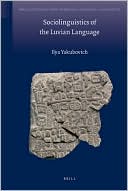 Luvian is the language of Anatolian hieroglyphic inscriptions and a close relative of Hittite. This book explores the Luvian ethnic history through sociolinguistic methods, with an emphasis on the interpretation of contacts between Luvian and its linguistic neighbors, such as Hittite, Hurrian, and Greek. It is concluded that Luvian was originally spoken in the central part of Anatolia. Subsequent Luvian migrations were connected with the expansion of the Hittite state, where Hittite was the socially dominant language, but the Luvian speakers were more numerous. The unstable balance between the Hittite and the Luvian speakers continued to shift in favor of the second group, to the point that the Hittite elites were fully bilingual in Luvian...
Luvian is the language of Anatolian hieroglyphic inscriptions and a close relative of Hittite. This book explores the Luvian ethnic history through sociolinguistic methods, with an emphasis on the interpretation of contacts between Luvian and its linguistic neighbors, such as Hittite, Hurrian, and Greek. It is concluded that Luvian was originally spoken in the central part of Anatolia. Subsequent Luvian migrations were connected with the expansion of the Hittite state, where Hittite was the socially dominant language, but the Luvian speakers were more numerous. The unstable balance between the Hittite and the Luvian speakers continued to shift in favor of the second group, to the point that the Hittite elites were fully bilingual in Luvian...More books on this:
* Sociolinguistics of the Luvian Language » Barnes & Noble.com
* Luwian Language: Luwian Inscriptions, Cuneiform Script, Luwian Language
* Anatolian Inscriptions: Hittite Texts, Luwian Inscriptions, Lycian Inscriptions, Letoon Trilingual, Kikkuli, Illuyanka, Milawata Letter
* Anatolian Hieroglyphs: Hieroglyphic Luwian, Crook-Staff, Sa-Sub4: Created by LLC Books,Paperback, English-language edition,Pages:24,Pub by Books LLC